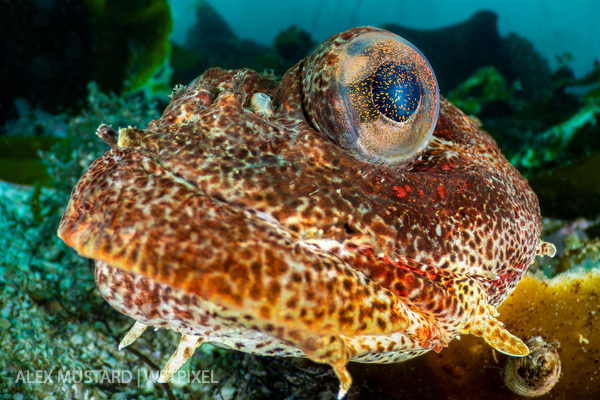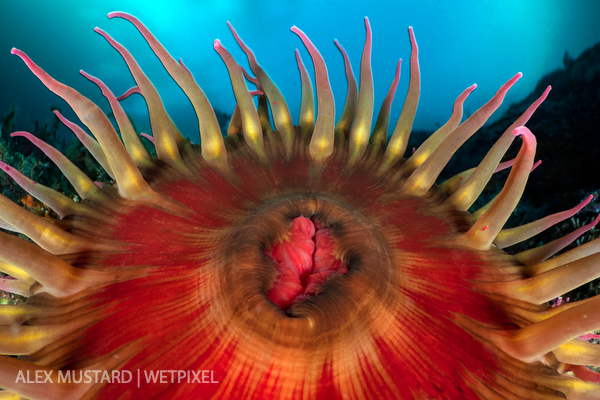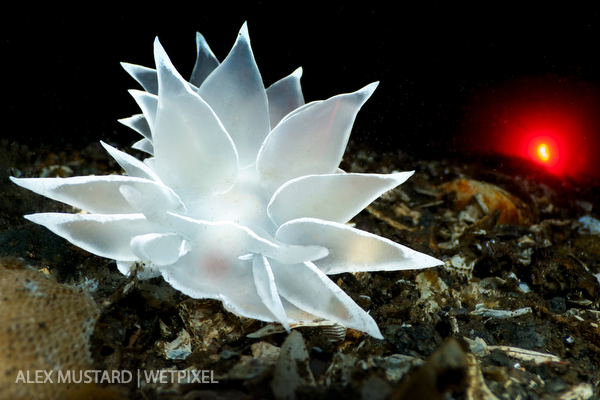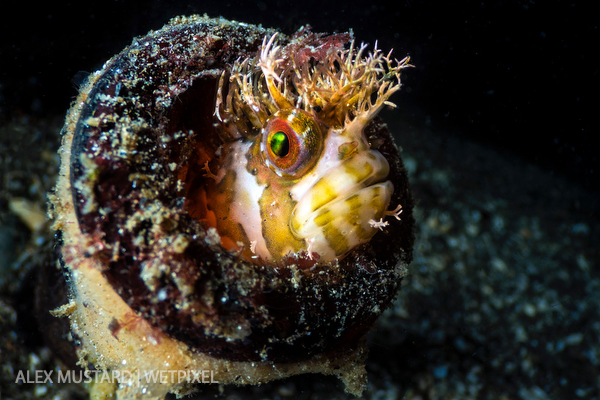Field Review: Nauticam EMWL With 160 Degree Lens by Alex Mustard
Field Review: EMWL – 160 degree lens
By Alex Mustard
Nauticam introduced the EMWL lens in the second half of 2020, a timing that meant that many owners still haven’t given the lens the workout it deserves. I have been itching to shoot it in one of the muck diving meccas of SE Asia, but I still haven’t had the chance. But the limited travel opportunities for owners haven’t stopped Nauticam’s development and they have just introduced a new lens option for the modular system. And excitingly, it is the widest yet – a 160˚ optic. I had the chance to test a production-ready prototype on a recent trip to God’s Pocket Resort, Canada.

INTRODUCTION
The EMWL lens is designed for extreme WAM (Wide Angle Macro) imagery, where a small subject is photographed at macro levels of magnification, but within a wide angle scene. Nauticam designed the lens to be modular, with interchangeable final objective lenses, to allow the user to alter the angle of view underwater. Three objective lenses were introduced with the EMWL in 2020: the 130˚, the 110˚, and 60˚. New for 2022 is the 160˚, which enticingly is not only wider, but also has a small front element which helps increase how large the subject appears in the picture.
The 160 then is exciting as it makes the EMWL better at what it does. The wider view allows us to set the subject against the widest background, while the small size of the front element boosts subject to size, while also letting us get the lens right down to the smallest subjects creating the famous “bug-eye” view. The small size also makes it easier to light the subject when it is very close to the lens, because there is almost no shading on the subject. In short, the 160˚ objective is theoretically the most powerful option in the range. The EMWL is designed for extreme WAM images, and the 160 is the most extreme option.

That’s all good in theory, but the challenge for Nauticam was making this small and wide angle lens deliver usable image quality despite the more extreme optics. How sharp will it be in the center of the frame? And is it sharp right out to the edges? I attached it to my Nikon D850 and plunged it into the chilly waters of British Columbia to find the answer. I wanted to find out if you are an existing EMWL owner should you be adding this lens to your system and if you are a prospective owner, is this the lens that convinces you to buy the EMWL

SHARPNESS AND IMAGE QUALITY
The important stuff first – the sharpness is excellent. I was prepared for a drop compared to the 130, which was previously my most used lens choice, but I found no noticeable shortfall. The 160 is sharp in the center of the frame and sharp on the edges of the frame. The example images show an off-center eye, showing excellent detail, even zoomed right in on a D850 high-resolution file. The EMWL isn’t quite a match for sharpness as the WACP or a macro prime lens, but it is way, way in excess of any other ‘bug-eye’ style lens I have tried or seen.

It just took one dive to convince me about the 160. In the water, I loved the angle of view I was getting and the shots it produced. And once I downloaded them and looked at them in detail back in the Resort, I was sold on the quality. I used the 160 for almost every EMWL shot for the remainder of the trip.

Although a much smaller point, I think that there is more of a deviation from the WACP image quality in terms of the color rendering and highlight capture of the EMWL. The subtle variation of the hues captured by the EMWL is inferior to my prime lenses or the WACP. They are very acceptable, as you can see, but not perfect. Perhaps the cause of this is that I find the many elements of my EMWL create quite a warm image. I often have to process images below 4000K in Lightroom to get neutral colors. I wonder if this quite extreme white balance is squashing the color information a bit? These are minor points and don’t cause me reservations about using the lens, but I mention them for the record. I did find the new 160 handled the sun well when it was in the frame. The EMWL lenses can suffer flare and internal reflections when shot towards the light. Nauticam makes lens hoods for all objectives. I rarely use these as they bulk up the lenses and stop you from maneuvering and lighting quite so close to the subjects. Even shooting into the light regularly with the 160˚ objective, I didn’t encounter any flare or reflections in Canada despite never using the hood.

HANDLING
This is a good opportunity to share some general insight about shooting the EMWL system. Good news: it is easier to shoot than you would ever imagine from looking at it on land. But only with correct buoyancy. I use two 9” Popeye buoyancy arms up front, to counteract the lens. I mount three bayonets on my arms. This has two advantages. First, I can go into the water with a normal size compact rig, with the focusing unit attached to the port, and the relay and two optics on the bayonets on the arms. This helps whether the rig is being passed down from a boat, or you are carrying it in on a shore entry. Either way, you need to assemble the system underwater to ensure there are no air bubbles trapped in the joints, so there is no point in entering the water with it built. Second, the spare bayonets are invaluable when switching objectives, because they provide somewhere to put the objective you have taken off before you can attach another. This is especially important when diving on a wall while wearing thick gloves! Finally, I never find I take the EMWL off completely and shoot normal macro. While this is possible it is a pain, as you need somewhere to put the EMWL, and it involves completely repositing the strobes and changing all the camera and strobe settings.

FOCUS AND DEPTH OF FIELD
Autofocus works well with the EMWL, but the focus point is critical because the greater the subject magnification in the frame the smaller the depth of field. While WAM is promoted as a technique for shooting a critter framed against a wide angle background, with smaller subjects, you are likely to have a very minimal depth of field. Any small error with focus will be punished. Like with macro, I use a single point and make sure I make the effort to move the AF point to the critical feature of the subject.
The other issue of limited depth of field is that we need to stop the lens down, as much as possible to have some sort of detail in the background. However, shutting the aperture makes it more of a challenge to achieve a balanced light image (to show that all-important wide angle background). This was especially true in dark Canadian waters, where long exposures are often necessary to capture any ambient light. You can of course shoot the EMWL with a fast shutter speed and black background, but that to some extent defeats the object of the objective. To make things easier, I tend to favor shooting the lens on sunny days, and towards the middle of the day for maximum ambient light levels.
The settings I favor are f/18-f/20 (to maximize DoF), with the ISO around 320-640 to help capture the ambient light, but I still find I am shooting quite slow exposures depending on conditions. One plus of shooting the EMWL is that my strobes are on very low power because they are so close to the subject, which makes it is easy to shoot a series and edit afterward for focus errors and background blur from camera shake.
A focus light really helps in nailing the critical focus. I use my strobes as my focus light with the EMWL because their aiming light turns off for a second after firing so it does not show up in my images (as long as I am shooting on front/first curtain synch).

SUBJECT SELECTION
Wherever you shoot it, the key to success with the EMWL is the right subject. To produce macro levels of magnification with a wide angle lens, you need to maneuver that lens very close to the subject. The long barrel length of the EMWL does help in this regard, as it keeps us out of the face of the subject, but it is still a lens suited to non-moving and territorial subjects, which will allow a close approach. In Canada, this meant I was focused on nudibranchs, shrimps, crabs, red Irish lords (a sculpin that looks a lot like a small scorpionfish), and sea anemones. The lens is also very well suited to shooting wide angle in places you couldn’t get a larger rig, like right inside subjects like anemones or on life thriving between the thick stems of a forest of seaweed.

I also wanted to test the lens at slightly longer camera-to-subject distances. To see if it could produce acceptable quality CFWA images in addition to its party-trick WAM images. While this is not the raison d’etre of the EMWL, it is jolly handy to be able to bag a wider variety of imagery on a dive. I was pleased that the 160 was happily able to capture these images.

CONCLUSION
So should you buy one? First up for existing EMWL users – it is an easy yes. The 160 simply makes the EMWL better at what it is designed for. It is a no-brainer. The only downside I can think of is that it makes you question the usefulness of the other objectives. Certainly, it is always better to have options, but I can definitely see myself traveling with just the 160 on trips when baggage allowance is tight.

I suspect it will be less straightforward for video shooters to opt for the 160, as the existing 130 lens is probably already the WAM video sweet spot. I’ve never shot any video with the EMWL (or my D850 for that matter) but I did enjoy the footage I’ve seen from Eric’s recent trip to the Philippines with the 130.
For newcomers to the EMWL system the purchase will depend a lot on circumstances. The EMWL is expensive and is a special effect lens – not a lens you use on every dive – so its purchase takes some justifying. Also, it is not a lens suited to all destinations. Despite having one, I don’t pack it for every trip, its use really depends on the type of diving and subjects I am expecting to encounter. Even with the fancy new lens, I only used it on 6 of my 33 dives in Canada. I do think it is a good lens to consider buying with a friend, so you can share it on trips and have it for yourself when not traveling together! But for me, quite clearly, the new 160 makes the EMWL considerably more desirable.

FTC Disclosure
The EMWL lens and the objective(s) were supplied to the reviewer for the purpose of the review by Nauticam. Many thanks for their assistance.